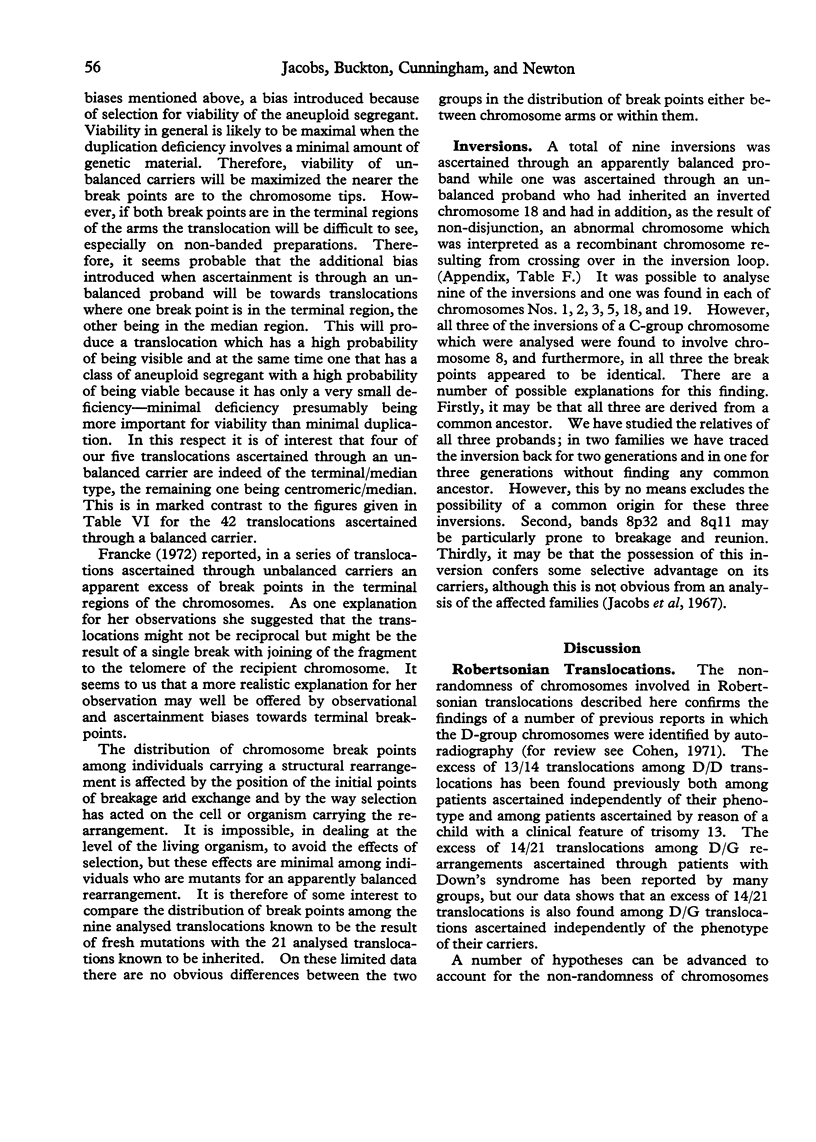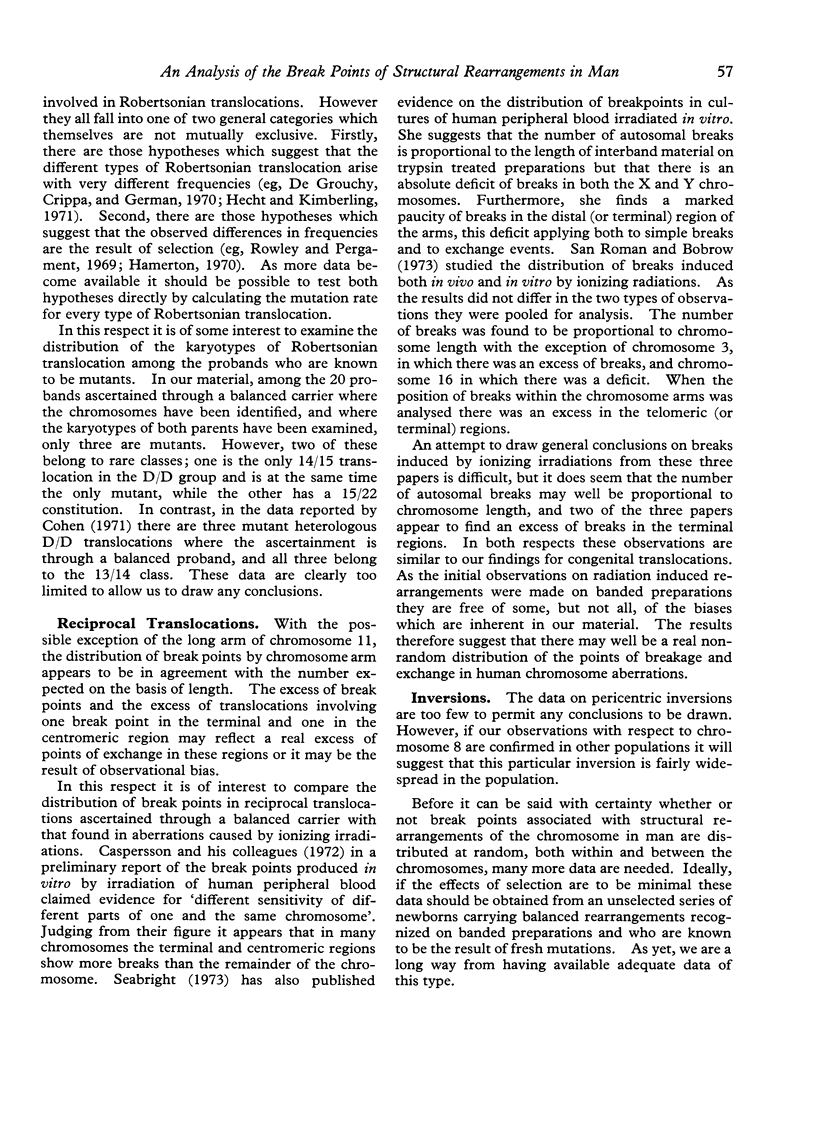Abstract
The distribution of the points of breakage and reunion of a series of 58 Robertsonian translocations, 53 reciprocal translocations, and 10 inversions is described. An excess of 13/14 and 14/21 rearrangements was found among the Robertsonian translocations, this excess being independent of the method of ascertainment of the proband. The distribution of break points between chromosome arms in the reciprocal translocations, with the possible exception of the long arms of chromosome 11, was no different from that expected on the basis of their relative lengths. However, within arms there appeared to be an excess of breaks in the terminal regions, an excess of terminal/centromeric translocations where ascertainment was through a balanced carrier and a possible excess of terminal/median translocations where ascertainment was through an unbalanced carrier. Nine inversions were analysed and three of these involved identical break points on chromosome 8.
Possible reasons for the apparent non-randomness of points of breakage and exchange are discussed and it is concluded that the techniques of preparation, methods of observations, and methods of ascertainment all affect the distribution of observed points of breakage and exchange and must therefore be taken into cognizance in any study of chromosome rearrangements in man.
Full text
PDF














Selected References
These references are in PubMed. This may not be the complete list of references from this article.
- Caspersson T., Haglund U., Lindell B., Zech L. Radiation-induced non-random chromosome breakage. Exp Cell Res. 1972 Dec;75(2):541–543. doi: 10.1016/0014-4827(72)90469-7. [DOI] [PubMed] [Google Scholar]
- Cohen M. M. The chromosomal constitution of 165 human translocations involving D group chromosomes identified by autoradiography. Ann Genet. 1971 Jun;14(2):87–96. [PubMed] [Google Scholar]
- Francke U. Quinacrine mustard fluorescence of human chromosomes: characterization of unusual translocations. Am J Hum Genet. 1972 Mar;24(2):189–213. [PMC free article] [PubMed] [Google Scholar]
- Hecht F., Kimberling W. J. Patterns of D chromosome involvement in human (DqDq) and (DqGq) Robertsonian rearrangements. Am J Hum Genet. 1971 Jul;23(4):361–367. [PMC free article] [PubMed] [Google Scholar]
- Jacobs P. A., Cruickshank G., Faed M. J., Frackiewicz A., Robson E. B., Harris H., Sutherland I. Pericentric inversion of a group C autosome: a study of three families. Ann Hum Genet. 1968 Jan;31(3):219–230. doi: 10.1111/j.1469-1809.1968.tb00552.x. [DOI] [PubMed] [Google Scholar]
- Jacobs P. A., Frackiewicz A., Law P. Incidence and mutation rates of structural rearrangements of the autosomes in man. Ann Hum Genet. 1972 Mar;35(3):301–319. doi: 10.1111/j.1469-1809.1957.tb01403.x. [DOI] [PubMed] [Google Scholar]
- O'Riordan M. L., Robinson J. A., Buckton K. E., Evans H. J. Distinguishing between the chromosomes involved in Down's syndrome (trisomy 21) and cronic myeloid leukaemia (Ph1) by fluorescence. Nature. 1971 Mar 19;230(5290):167–168. doi: 10.1038/230167a0. [DOI] [PubMed] [Google Scholar]
- Roman C. S., Bobrow M. The sites of radiation induced-breakage in human lymphocyte chromosomes, determined by quinacrine fluorescence. Mutat Res. 1973 Jun;18(3):325–331. doi: 10.1016/0027-5107(73)90217-0. [DOI] [PubMed] [Google Scholar]
- Rowley J. D., Pergament E. Possible non random selection of D group chromosomes involved in centric-fusion translocations. Ann Genet. 1969 Sep;12(3):177–183. [PubMed] [Google Scholar]
- Seabright M. High resolution studies on the pattern of induced exchanges in the human karyotype. Chromosoma. 1973;40(4):333–346. doi: 10.1007/BF00399426. [DOI] [PubMed] [Google Scholar]
- Sumner A. T., Evans H. J., Buckland R. A. New technique for distinguishing between human chromosomes. Nat New Biol. 1971 Jul 7;232(27):31–32. doi: 10.1038/newbio232031a0. [DOI] [PubMed] [Google Scholar]
- de Grouchy J., Crippa L., German J. Etudes autoradiographiques des chromosomes humains. VII. Cinq observations de t(DqDq) familiales. Ann Genet. 1970 Mar;13(1):19–37. [PubMed] [Google Scholar]


